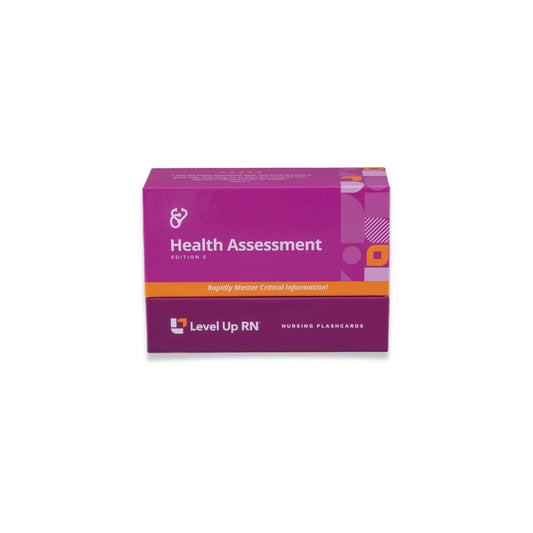Hi, I'm Meris with Level Up RN. And in this video, I'm going to be reviewing with you the type, function, and assessment of cranial nerve III, oculomotor. I'm going to be following along using our Health Assessment flashcards. These are available on our website, leveluprn.com, if you want to get a set of your own. Or if you are more interested in digital flashcards, you should definitely check these out using our digital flashcards called Flashables. All right, let's go ahead and get started.
So we are talking about cranial nerve number III, oculomotor. And luckily, its name tells you what it does. Oculo meaning eyes and motor meaning to move. So its type is that it is a motor neuron, but its function is that it controls most eye movements and also pupillary constriction.
So how do we assess cranial nerve III? I'm so glad you asked. We have a bunch of different ways that we can assess this cranial nerve. So first on our list is the corneal light reflex. And the way that the corneal light reflex works is, in this instance, we're going to be looking at the patient from a distance, so about 12 inches away. I'm going to take my pen light and I'm going to shine it directly at the center of my patient's nose, like right here. And what I'm looking for is I want my patient to look straight ahead, and I want to see where that light that I'm shining is reflected in their eyes. So they're going to look straight ahead, and I'm going to shine the light in their eyes. And I'm going to look and see, is that light being reflected in the same area of that eye? So I should see it in, plus or minus, right around the same area. However, if my patient has some sort of deviated eye alignment, such as strabismus, then I may see that that light appears in a different position for the deviated eye. So that is what the corneal light reflex is all about.
Now, let's talk about the cover test. And the cover test is used specifically to assess for strabismus. So we are looking for deviated alignment of the eyes. And the way we're going to do this is we're going to cover one of our patient's eyes like with a card, for instance. So I'm going to have my patient look straight ahead, and I'm going to take this card, and I'm going to cover one eye. And what I expect to see is that the uncovered eye should just continue staring straight ahead. It shouldn't move, and it should have a nice, steady, fixed gaze. However, if I cover the eye and I see that the uncovered eye begins to deviate one way or the other, up, down, to the side, internally, wherever it may be deviating, that is an abnormal finding that would be possibly suggestive of strabismus. I'm going to repeat that by looking at the other eye as well. So that is what the cover test is assessing for.
And lastly, we can assess this cranial nerve using these six cardinal positions of gaze. And if you have your cards, then I've got this nice illustration for you of the six cardinal positions of gaze in the flashcards. But six cardinal positions of gaze is where we are going to have the patient focus on something such as my finger or a pen. We're going to have the patient follow that pen or finger from about a foot away, about 12 inches away. And we're going to do that in six different positions. So we're going to start in the middle, and we're going to go up, to the side, and down. And then we're going to do it on the other side, up, to the side, and down. Now, what am I looking here? I'm looking for a couple of things when I do this test. I'm looking to make sure that my patient is able to follow my instructions. I'm looking sure that they are able to move their eyes in all of the directions that we are moving this pen.
But what I am looking for most especially is something called nystagmus. And nystagmus is this rhythmic beating of the eyes. And if you've never seen this before, the best way that I can describe it is, you have experienced this when you were a child or even right now, if you got really dizzy. Let's say you stood up and you spun around in a circle over and over and over, and then you stopped, and you tried to look straight ahead. You will have that rhythmic beating of your eyes. You may also see this in some people who are intoxicated, like with alcohol. And it can also be a sign of some types of head trauma. Different types of head injury can cause nystagmus as well. So when we are doing six cardinal positions of gaze, we are assessing for nystagmus.
All right. So that is it for assessment of cranial nerve number III. I've got some quiz questions to test your knowledge of key facts that I provided in this video. What term is used to describe the involuntary rhythmic beating motion of the eyes? Nystagmus. Which test or tests is or are used to assess for strabismus? The cover test and corneal light reflex. Is cranial nerve III sensory, motor, or both? Motor.
All right, that is it for this video. I hope that you found this information useful. Thank you so much, and happy studying.


